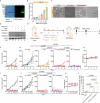Lysosomal Cathepsin S Escape Facilitates Near Infrared Light-Triggered Pyroptosis Via an Antibody-Indocyanine Green Conjugate
- PMID: 40539828
- PMCID: PMC12442674
- DOI: 10.1002/advs.202504851
Lysosomal Cathepsin S Escape Facilitates Near Infrared Light-Triggered Pyroptosis Via an Antibody-Indocyanine Green Conjugate
Abstract
Pyroptosis is a proinflammatory programmed cell death (PCD) that is causally linked to antitumor immune responses, but the therapeutic potential of pyroptosis has been limited by the lack of tumor-specific and controllable inducers. Here, it is reported that tumor-specific pyroptosis can be spatiotemporally triggered via near-infrared light (NIR-pyroptosis) by using an antibody-bound indocyanine green (ICG), a clinically approved and nontoxic fluorescent dye. Mechanistically, the key molecular steps are identified by which antibody-bound ICG generates excessive reactive oxygen species (ROS) within lysosomes after internalization, leading to lysosomal membrane damage and the cytosolic release of cathepsin S (CTSS), which cleaves gasdermin D (GSDMD), IL-18, and IL-1β independently of caspase-1, and thereby induces pyroptosis, while other cathepsin family members fail to cleave GSDMD. Functionally, in both ICAM1+ and HER2+ solid tumors, antibody-bound ICG-mediated NIR-pyroptosis triggers potent and durable antitumor immune responses through the release of proinflammatory cytokines. Furthermore, NIR-pyroptosis synergize with anti-PD-1 therapy by activating adaptive immune cells via upregulated IFN-γ secretion. The findings identify CTSS as a novel enzyme for GSDMD cleavage and establish NIR-pyroptosis as a non-apoptotic anticancer modality, providing a promising opportunity to overcome apoptosis resistance in current cancer therapies.
Keywords: antibody‐drug conjugate; anti‐tumor immunity; pyroptosis.
© 2025 The Author(s). Advanced Science published by Wiley‐VCH GmbH.
Conflict of interest statement
F.C., W.H.Z. and P.G. are co‐inventors of a patent filed by Zhejiang Cancer Hospital and Hangzhou Institute of Medicine, Chinese Academy of Sciences. X.F.L. and J.F. are shareholders of MabPlex. The other authors declare no conflict of interest.
Figures







References
-
- Delbridge A. R., Grabow S., Strasser A., Vaux D. L., Nat. Rev. Cancer 2016, 16, 99. - PubMed
MeSH terms
Substances
Grants and funding
- 82172598/National Natural Science Foundation of China
- 82373782/National Natural Science Foundation of China
- 82202231/National Natural Science Foundation of China
- T2188102/National Natural Science Foundation of China
- 92353000/National Natural Science Foundation of China
- LZ22H310001/Natural Science Foundation of Zhejiang Province, China
- 2024HIAS-V008/the Research Funds of Hangzhou Institute for Advanced Study
- 2023YFC3404003/National Key Research and Development Program
- 2024SDYXS0001/the Key Research and Development Program of Zhejiang Province
- the 551 Health Talent Training Project of Health Commission of Zhejiang Province
- ERC2024014/the Joint Research Program of Eye Research Center
- the Qiantang Interdisciplinary Research Grant
LinkOut - more resources
Full Text Sources
Research Materials
Miscellaneous
